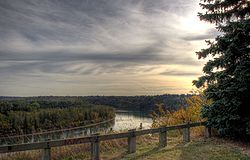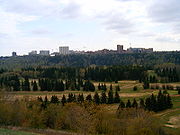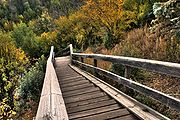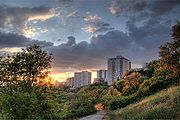
North Saskatchewan River valley parks system
Encyclopedia




Urban park
An urban park, is also known as a municipal park or a public park, public open space or municipal gardens , is a park in cities and other incorporated places to offer recreation and green space to residents of, and visitors to, the municipality...
s in the North Saskatchewan River
North Saskatchewan River
The North Saskatchewan River is a glacier-fed river that flows east from the Canadian Rockies to central Saskatchewan. It is one of two major rivers that join to make up the Saskatchewan River....
valley of Edmonton
Edmonton
Edmonton is the capital of the Canadian province of Alberta and is the province's second-largest city. Edmonton is located on the North Saskatchewan River and is the centre of the Edmonton Capital Region, which is surrounded by the central region of the province.The city and its census...
, Alberta
Alberta
Alberta is a province of Canada. It had an estimated population of 3.7 million in 2010 making it the most populous of Canada's three prairie provinces...
.
Edmonton's river valley comprises over 20 major parks and attractions and forms one of the largest expanses of connected urban parkland in North America
North America
North America is a continent wholly within the Northern Hemisphere and almost wholly within the Western Hemisphere. It is also considered a northern subcontinent of the Americas...
. Referred to as a "Ribbon of Green", the public river valley parks provide a unique urban escape area with park styles ranging from fully serviced urban parks to campsite-like facilities with few amenities. At 7400 ha (18,285.8 acre) in size and 48 km (29.8 mi) in length, the river valley parks system consists of 22 ravines, which have a combined total length of 103 km (64 mi). It also includes 11 lakes. Most of the city has bike and walking trail connections. These trails are also part of the 235 km (146 mi) Waskahegan walking trail
Waskahegan Trail
The Waskahegan Trail is a walking/hiking trail that runs through and around Edmonton, Alberta, Canada. It is 309 km and runs through a mix of public and private land. Landowners are paid nothing. Their permission is given on the understanding that it can be withdrawn at any time for any reason...
.
Several golf courses, both public and private, are also located in the river valley. The long summer daylight hours of this northern city provide for extended play well into the evening. Golf courses and the park system become a winter recreation area during this season. Cross-country skiing and skating are popular during the long winter. Four downhill ski slopes are located in the river valley as well, two within the city and two immediately outside.
The City of Edmonton has named five parks in its river valley parks system in honour of each of "The Famous Five
The Famous Five (Canada)
The Famous Five or The Valiant Five were five Canadian women who asked the Supreme Court of Canada to answer the question, "Does the word 'Persons' in Section 24 of the British North America Act, 1867, include female persons?" in the case Edwards v...
".
Parks and facilities
The largest area in the river valley is occupied by municipal parks:- Hermitage Park
- Forest Heights Park
- Emily Murphy Park
- Rundle Park
- Dawson Park
- William Hawrelak ParkWilliam Hawrelak ParkWilliam Hawrelak Park is a park in Edmonton, Alberta. It is named after former mayor William Hawrelak, and was formerly known as Mayfair Park.The park is situated in Edmonton's river valley, next to the North Saskatchewan River...
- Gold Bar Park
- Louise McKinney Park
- Sir Wilfrid Laurier Park
- Goldstick Park
- Queen Elizabeth Park
- Whitemud Park
- Capilano Park
- Kinsmen Park
- Terwillegar Park
- Kinnaird Park and Ravine
- Victoria Park
The City also operates several public facilities in the river valley:
- Fort Edmonton ParkFort Edmonton ParkFort Edmonton Park is an attraction in Edmonton, Alberta, Canada. Named for the first enduring European post in the area of modern-day Edmonton, the park is the largest living history museum in Canada by area...
- Edmonton Valley Zoo
- Muttart ConservatoryMuttart ConservatoryThe Muttart Conservatory is a botanical garden located in the North Saskatchewan river valley, across from downtown Edmonton. The conservatory consists of four glass, pyramid-shaped structures that showcase plants from arid, tropical, and temperate climates, providing a welcome oasis of warmth...
- John Janzen Nature Centre
- Riverside Golf Course
- Victoria Golf Course (the oldest municipal course in Canada)
- Rundle Park Golf Course
The provincial government owns the following sites in the river valley:
- Strathcona Science Provincial ParkStrathcona Science Provincial ParkStrathcona Science Provincial Park is a provincial park in Alberta, Canada, located between Edmonton and Sherwood Park, south of the Yellowhead Highway and west of Highway 216....
- Alberta Legislature Building and grounds
- Royal Alberta MuseumRoyal Alberta MuseumThe Royal Alberta Museum is located in Edmonton, Alberta and was named the Provincial Museum of Alberta until 24 May 2005 when Queen Elizabeth II visited, bestowing royal patronage. It has a natural history exhibit, a wildlife exhibit, an entomology exhibit, a Native Culture exhibit, as well as...
and Government HouseGovernment House (Alberta)Government House is the former official residence of the lieutenant governors of Alberta, currently retained for ceremonial events and entertaining.The property for the house was purchased by the Province of Alberta in 1910, as well as the surrounding area...
Hiking, cycling, and multi-use trails run throughout these parks and connect to other trails through the city and outside as well forming an integrated system. The river valley parks in particular are part of the Waskahegan
Waskahegan Trail
The Waskahegan Trail is a walking/hiking trail that runs through and around Edmonton, Alberta, Canada. It is 309 km and runs through a mix of public and private land. Landowners are paid nothing. Their permission is given on the understanding that it can be withdrawn at any time for any reason...
and Trans Canada
Trans Canada Trail
The Trans Canada Trail is a proposed corridor in Canada. The creation of the trail was announced as part of Canada's 125th anniversary celebrations in 1992. It is expected that when complete, it will be the longest recreational trail in the world...
trail systems.
Wildlife

Edmonton's streets and parklands are also home to one of the largest remaining concentrations of healthy American Elm
American Elm
Ulmus americana, generally known as the American Elm or, less commonly, as the White Elm or Water Elm, is a species native to eastern North America, occurring from Nova Scotia west to Alberta and Montana, and south to Florida and central Texas. The American elm is an extremely hardy tree that can...
trees in the world, unaffected by Dutch Elm disease
Dutch elm disease
Dutch elm disease is a disease caused by a member of the sac fungi category, affecting elm trees which is spread by the elm bark beetle. Although believed to be originally native to Asia, the disease has been accidentally introduced into America and Europe, where it has devastated native...
, which has wiped out vast numbers of such trees in eastern North America. Jack Pine
Jack Pine
Jack pine is a North American pine with its native range in Canada east of the Rocky Mountains from Northwest Territories to Nova Scotia, and the northeast of the United States from Minnesota to Maine, with the southernmost part of the range just into northwest Indiana...
, Lodgepole Pine
Lodgepole Pine
Lodgepole Pine, Pinus contorta, also known as Shore Pine, is a common tree in western North America. Like all pines, it is evergreen.-Subspecies:...
, White Spruce
White Spruce
Picea glauca is a species of spruce native to boreal forests in the north of North America, from central Alaska east to Newfoundland, and south to northern Montana, Minnesota, Wisconsin, Michigan, upstate New York, Vermont, New Hampshire, and Maine; there is also an isolated population in the...
, White Birch
White Birch
White Birch may refer to:* Betula papyrifera* Betula pendula* Shirakabaha, Japanese literary group* The White Birch , Norwegian recording artists...
, Aspen
Aspen
Populus section Populus, of the Populus genus, includes the aspen trees and the white poplar Populus alba. The five typical aspens are all native to cold regions with cool summers, in the north of the Northern Hemisphere, extending south at high altitudes in the mountains. The White Poplar, by...
, Green Ash
Green Ash
Fraxinus pennsylvanica is a species of ash native to eastern and central North America, from Nova Scotia west to southeastern Alberta and eastern Colorado, south to northern Florida, and southwest to eastern Texas....
, Basswood, various poplar
Poplar
Populus is a genus of 25–35 species of deciduous flowering plants in the family Salicaceae, native to most of the Northern Hemisphere. English names variously applied to different species include poplar , aspen, and cottonwood....
s and willows, and Manitoba Maple are also abundant; Bur Oak
Bur oak
Quercus macrocarpa, the Bur Oak, sometimes spelled Burr Oak, is a species of oak in the white oak section Quercus sect. Quercus, native to North America in the eastern and midwestern United States and south-central Canada...
is increasingly popular. Introduced tree species include Blue Spruce
Blue Spruce
Picea pungens is a species of spruce native to western North America, from southeast Idaho and southwest Wyoming, south through Utah and Colorado to Arizona and New Mexico. It grows at high altitudes from altitude, though unlike Engelmann Spruce in the same area, it does not reach the alpine...
, Norway Maple
Norway Maple
Acer platanoides is a species of maple native to eastern and central Europe and southwest Asia, from France east to Russia, north to southern Scandinavia and southeast to northern Iran....
, Red Oak, Sugar Maple
Sugar Maple
Acer saccharum is a species of maple native to the hardwood forests of northeastern North America, from Nova Scotia west to southern Ontario, and south to Georgia and Texas...
, Common Horse-chestnut
Common Horse-chestnut
Aesculus hippocastanum is a large deciduous tree, commonly known as Horse-chestnut or Conker tree.-Distribution:Aesculus hippocastanum is native to a small area in the mountains of the Balkans in southeast Europe, in small areas in northern Greece, Albania, the Republic of Macedonia, Serbia, and...
, McIntosh
McIntosh
The McIntosh Red is an apple cultivar with red and green skin, a tart flavor, and tender white flesh. It ripens in late September....
Apple, and Evans Cherry
Evans Cherry
Evans Cherry — is a sour cherry cultivar rediscovered in an old orchard near Edmonton, Alberta, Canada.It is significant as it was once thought that cherries would not grow in the harsh climate of the Canadian prairies, yet the first specimen, discovered, or more accurately, re-discovered, by Ieuan...
. Three walnut species -- Butternut
Butternut
Butternut may refer to:*Butternut tree, Juglans cinerea, or its fruit*Butternut squash, an edible winter squash.*Butternut, a shade of yellow similar to khaki and the color of the butternut squash...
, Manchurian Walnut and Black Walnut
Black Walnut
Juglans nigra, the Eastern Black walnut, is a species of flowering tree in the hickory family, Juglandaceae, that is native to eastern North America. It grows mostly in riparian zones, from southern Ontario, west to southeast South Dakota, south to Georgia, northern Florida and southwest to central...
-- have survived in Edmonton.
Politics and planning
The River Valley Alliance is a grouping of municipal governments in the Edmonton regionEdmonton Capital Region
The Edmonton Capital Region , also commonly referred to as the Alberta Capital Region, Greater Edmonton or Metro Edmonton, is a conglomeration of municipalities centred around Edmonton – Alberta's provincial capital....
that have committed to expanding the River Valley Parks System outside of Edmonton's city limits. The plan calls for a 18000 acres (72.8 km²) zone to be called the "Capital Region Valley Park" stretched over 88 kilometres running from Devon
Devon, Alberta
Devon is a town in the province of Alberta, Canada, situated southwest of Edmonton, the provincial capital, and located along the banks of the North Saskatchewan River.- History :Devon owes its existence to one of the largest oil discoveries in the world...
to Fort Saskatchewan.
In January 2008, the City of Edmonton paid a record C$7 million to buy a parcel of land to fill in a gap in the otherwise continuous chain of parks. The city further promised to spend C$20 million of pedestrian bridges and trails, but said that the as yet unnamed park would be left in an undeveloped state.

